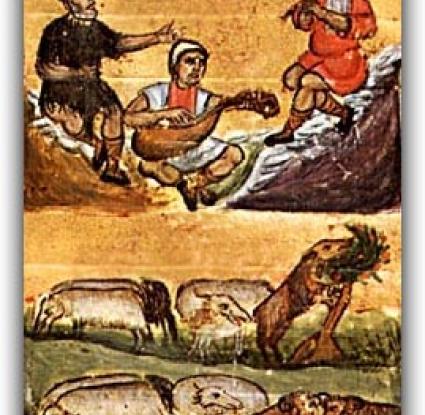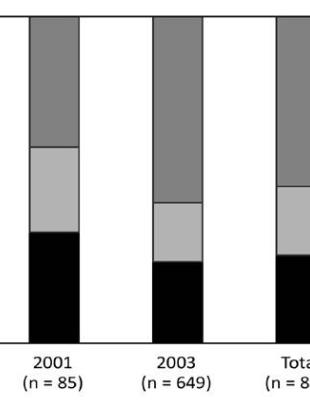
Αγροτική σκηνή. Λεπτομέρεια από μικρογραφία χειρογράφου, 11ος αι.Άγιον Όρος, Μονή Εσφιγμένου, κώδ. 14 (Μηνολόγιο), φ. 386α.Σ. Πελεκανίδης, Π. Xρήστου, Χρ. Μαυροπούλου-Tσιούμη, Σ. Καδάς, Σ., 1975. Oι Θησαυροί του Aγίου Όρους: Εικονογραφημένα Xειρόγραφα, παραστάσεις-επίτιτλα-αρχικά γράμματα, Τόμος Β, εικ. 346, σελ. 225. Αθήνα: Eκδοτική Aθηνών A.E.

Meat consumption in the Byzantine era.
Name - Origin
Κρέας. The Byzantines were mainly meat-eaters, although Byzantine sources seem to emphasise on the vegetables and legumes consumed during periods of fasting (Vionis et al. 2010, pp. 455-456). In general, Byzantines in every corner of the Empire consumed meat that was obtained from domesticated animals such as sheep, goats, pigs and oxen, but also from domesticated birds (such as quail) and poultry.
According to sources (Koukoules 1952, p. 48), the cooking methods of various meats were "ekzesta" or "efta" (boiled), "ofta" or "epsita" (roasted), or "tarichi" (cured). Gregory the Theologian, for example, mentions that farmers and shepherds used to cook meat by placing it in a clay pot with clean water over a fire.
Functional and symbolic role
Meat was, of course, one of the staple products consumed mainly by the wealthier classes, while the poorer classes limited their meat consumption to festive times such as Christmas and Easter. An important source of information is the work of F. Koukoules (1952, pp. 22-36), which includes numerous Byzantine written sources. These inform us that the Byzantines had a preference for lamb meat, especially the tender lamb of April, which they used to eat boiled or roasted (Motsias 1998, pp. 104-105). Pork meat ('moukteron') was also particularly popular; they used to make the so-called "hiromagiríes" (pork cooking) with cured or fresh meat. Pork was usually boiled with 'frígia' (cabbage or lettuce) and zucchini (Koukoules 1952, p. 53). Meat was very often cooked or garnished with garlic ("scordáton"), onions and leeks, while roasted meat was brushed with wine and honey (Motsias 1998, p. 106).
Additional information and bibliography
A new published study (Vionis et al. 2010, p. 423-464) on Byzantine cooking and tableware and the dietary habits of the rural population in Sagalassos (SW Asia Minor), based on excavated ceramic finds, the analysis of organic residues in pots, the study of animal bones and written sources, has shown that Byzantine inhabitants preferred mainly beef, while goat, sheep and pork meat were not absent from their diet. Examination of the pots in the same archaeological site indicated that the Byzantines' main method of cooking was boiling in medium-sized closed clay pots.
Koukoules F (1952) Βυζαντινών Βίος και Πολιτισμός. Τόμος Ε. Athens.
Motsias Ch. (1998) Τι έτρωγαν οι Βυζαντινοί. Athens: Kaktos publications.
S. Pelekanides, P. Christou, Chr. Mavropoulou-Tsioumi, S. Kadas, S., 1975. Oι Θησαυροί του Aγίου Όρους: Εικονογραφημένα Xειρόγραφα, παραστάσεις-επίτιτλα-αρχικά γράμματα, Τόμος Β. Eκδοτική Aθηνών A.E. Athens.
A. Vionis, J. Poblome, B. De Cupere, M. Waelkens, 2010. “A Middle-Late Byzantine Pottery Assemblage from Sagalassos: Typo-chronology and Sociocultural Interpretation”. Hesperia 79, σελ. 423-464.
Athanassios Vionis
